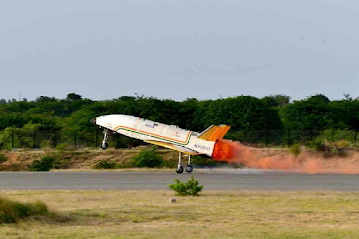Space debris is defined as “All non-functional, human-made objects, including no longer functioning spacecraft or fragments of them, in orbit or reentering Earth's atmosphere.” Since the start of the space age in 1957, humankind has launched almost 50 thousand tonnes of material into space. Some of that has returned, but today about 10 thousand tonnes remain in orbit and on average one object returns to Earth every week, uncontrolled.
These numbers are rapidly increasing. More satellites have been launched in the last two years than the entire six decades of space exploration. Earth's space environment is now filled with millions of bits of fast-moving debris, threatening our future in space. A collision with a 1 cm particle travelling 10 km/s (of which there are about a million in orbit) releases the same energy as a small car crashing at 40 km/h.
If current behaviours and trends in orbit continue, crucial orbital regions will become entirely unusable. It’s time to act.
How much debris is it OK to create? Ideally, zero debris.
Building on a decade of ESA-wide collaborative work, the Agency has taken the lead in space sustainability by introducing the ‘Zero Debris approach’: ESA's bold goal to significantly limit the production of debris in Earth and Lunar orbits by 2030 for all future missions, programmes and activities.
“We are seeing a dramatically increased use of space, but still insufficient technology to prevent the risks that follow. Our aim to become debris neutral in just a few years will require clearing precious Earth orbits once a mission is complete, and if the mission fails to do this, it must be actively removed by dedicated vehicles,” explains Holger Krag, ESA's Head of Space Safety.
“We are aiming for rules that compare to every national park on Earth – what you bring in you must take with you when you leave”.
ESA sets a new standard for space exploration
As part of the Zero Debris approach, ESA has updated its debris mitigation requirements and standards that will govern how the Agency's missions are designed, built, flown and disposed of, but also setting the rules for any company or institution that works with ESA on its missions.
In Autumn 2022, a large-scale study was carried out by ESA's Concurrent Design Facility involving all ESA sites across Europe as well as some 270 ESA experts, industry, governmental agencies and academia. The study put forward eight recommendations to reach Zero Debris by 2030, which form the foundation of the recently published ‘ESA Space Debris Mitigation Requirements’.
“ESA has always complied with the International Organization for Standardization (ISO) requirements when it comes to space debris mitigation – and we will continue to do so,” explains Paloma Villar, Head of ESA's Independent Safety Office.
“However, with the Zero Debris approach we go further still. Our 2030 target means newer, bolder requirements and technologies are needed, and we hope that ISO – and so the global space community – will evolve in the same way.” The deal between three leaders in the European space industry—Airbus Defence and Space, OHB, and Thales Alenia Space—and the European Space Agency (ESA). It was a big step forward in getting rid of space junk. Large platforms for satellites in Low Earth orbit (LEO) that meet Zero Debris guidelines are being built thanks to these contracts.
The Zero Debris Initiative
Space junk is becoming a bigger problem, so ESA came up with the Zero Debris method. By 2030, this new standard aims to stop the creation of space junk in Earth and moon orbits. As previously stated, the Zero Debris plan calls for strict changes to be made to designs. These changes will be enforced by the Space Debris Mitigation Standard, which will be put in place in 2023. This standard, which has the support of twelve countries and many businesses, lays out the necessary changes that must be made for future ESA flights to follow these new rules for preventing debris.
Space junk is becoming a bigger problem, so ESA came up with the Zero Debris method. By 2030, this new standard aims to stop the creation of space junk in Earth and moon orbits. As previously stated, the Zero Debris plan calls for strict changes to be made to designs. These changes will be enforced by the Space Debris Mitigation Standard, which will be put in place in 2023. This standard, which has the support of twelve countries and many businesses, lays out the necessary changes that must be made for future ESA flights to follow these new rules for preventing debris.
Broader Coverage and Future Steps
ESA is expanding its attempts to design satellites with no debris to include smaller satellites like CubeSats as well as bigger ones. This all-around method makes sure that all satellites, no matter their size or orbit, help keep the space environment healthy. Through these projects, ESA shows leadership that makes it possible for the space industry in Europe and around the world to adopt environmentally friendly methods that will keep space activities safe and going for a long time. Finally, the new contracts and the collaborative nature of this project are important steps toward reaching the Zero Debris by 2030 goal. They will also start a new era of space sustainability that is important for future space operations and adventures.
ESA is expanding its attempts to design satellites with no debris to include smaller satellites like CubeSats as well as bigger ones. This all-around method makes sure that all satellites, no matter their size or orbit, help keep the space environment healthy. Through these projects, ESA shows leadership that makes it possible for the space industry in Europe and around the world to adopt environmentally friendly methods that will keep space activities safe and going for a long time. Finally, the new contracts and the collaborative nature of this project are important steps toward reaching the Zero Debris by 2030 goal. They will also start a new era of space sustainability that is important for future space operations and adventures.
About Zero Debris standards
Zero Debris standards stress reducing building and demolition waste to almost nothing.
Zero Debris standards stress reducing building and demolition waste to almost nothing.
Important facts are:Started in Europe to make building areas more environmentally friendly.
They need things to be carefully sorted, recycled, and used again.Use cutting-edge tools for managing waste.Important because they help cut down on trash going to landfills. Help lower carbon emissions by wasting as little material as possible.They have to follow strict rules, like those for LEED approval.Legally required by local environmental rules.They encourage people to use products that are good for the environment.Push for architectural plans that take recycling at the end of life into account.Projects to get rid of all trash are in line with global environmental goals like the Paris Agreement.
Website Link : popularengineer.org
#ESA
#spaceexploration
#spacetechnology
#cleanspace
#spacedebris
#sustainablespace
#spacemission
#aerospace
#satellitetechnology
#environmentalprotection
#futureofspace
#spaceresearch
#spaceagency
#techinnovation
#satelliteinnovation
#spacefuture










